Photoshop has many built-in features and tools to make your artwork easier and more attractive. It also allows users to enhance their experience with Plug-ins. Note that Photoshop may refer to plug-ins as extensions. Learning how to install plugins in Photoshop is worth learning to do.
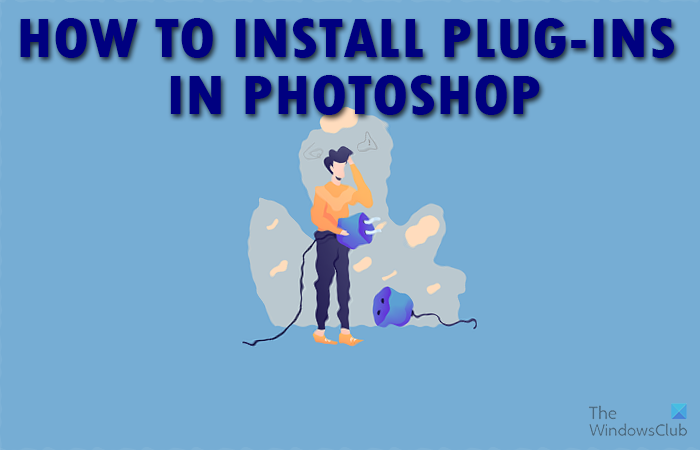
How to install Plug-ins in Photoshop
Plug-ins are additions or extensions that are created by a third party. They are used to enhance or add functions and features to Photoshop. Plug-ins can be used to automate tasks, especially those that you repeat consistently. Plug-ins can be downloaded from the internet for free or at a cost. It is, however, important to ensure that you download only from verifiable sources. Note that the steps and options available will depend on the version of Photoshop that you have. Bow here, we sill cover the following topics:
- Installing the plugins
- Using the installation file
- Manually placing the plug-in file in the folder
- Using additional folder
- Using the Plug-ins
- Removing the plug-ins
1] Installing the plug-ins
Installing plug-ins in Photoshop is quite easy. Some plug-ins have an installation file while some you will have to place in Photoshop’s plug-in folder. Note that the steps
Using the installation file
When you have located and downloaded the plug-in, you may have to unzip it. The unzipped plug-in may have an installation file which when used will place the plug-in into the correct folder making it accessible to Photoshop. Simply double-click on the installation file and follow the instructions to install. You may also right-click on the installation file and click Open. Follow the instructions to install the plug-in. When the installation is completed, open Photoshop to use the plug-in.
Manually placing the plug-in file in the folder
You can manually place the plug-in file into the Photoshop plug-in folder. If your plug-in comes in a zip file extract it. you then copy the .8BF and place it into the plug-in folder. Depending on the Photoshop version you are using the plug-in folder could be located in different places.
- For newer versions of Photoshop the plug-in folder is shared by all the Adobe apps and it is located at C:\Program Files\Common Files\Adobe\Plug-ins\CC.
- For older versions of Photoshop the plug-in folder is located in the Photoshop folder at C:\Program Files\Adobe\Photoshop (version)\Plug-ins\.
When you have placed the plug-in file into the plug-in folder, close and restart Photoshop if it was open or simply open Photoshop.
Using additional folder
Older versions of Photoshop support using additional folders for plug-ins. This option will tell Photoshop to look somewhere else for the plug-ins. This folder can be a central Plug-in folder that you use to keep plug-ins for all your graphics software to access. To allow Photoshop to access the additional folder do the following.
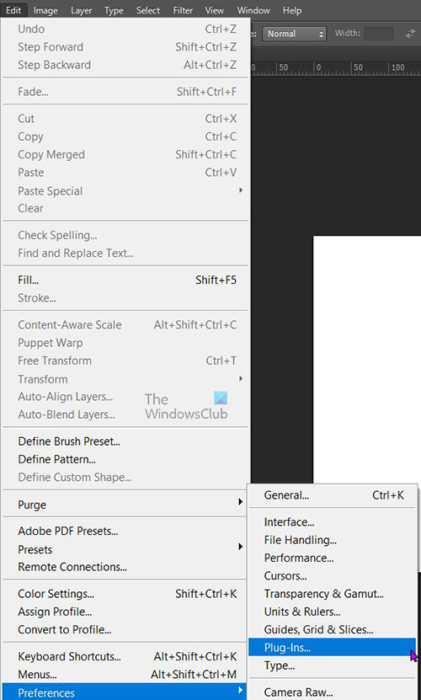
Go to the top menu bar and press Edit then Preferences then Plug-ins.
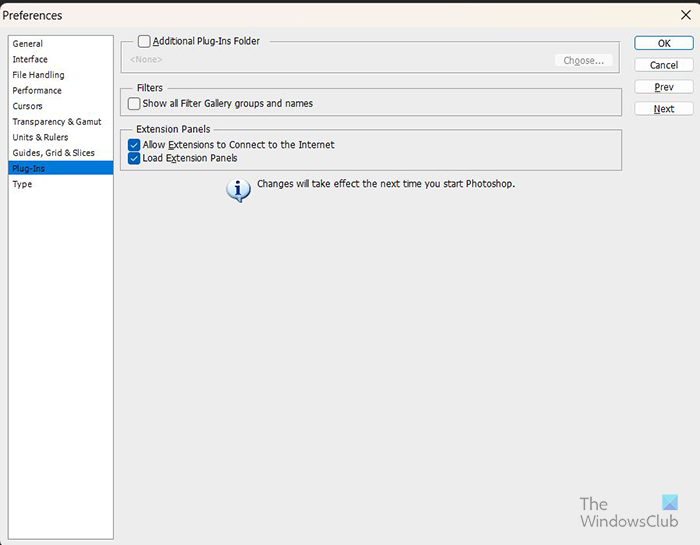
The Preferences options window will open, check the option beside Additional plug-ins folder.
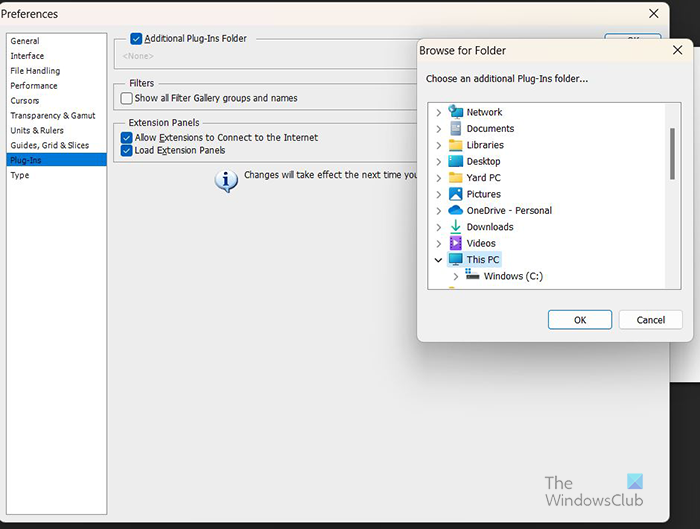
When you select Additional plug-ins folder, you will see the Browse for folder window popup. Choose the location of the central plug-in folder that you created. When you have located and selected the folder press OK. The Browse for folder window will close, click Choose to finish the operation. Press Ok to close the Preferences window. You then close and restart Photoshop if it was opened or just open Photoshop. Photoshop will now load the compatible plug-ins from this folder.
2] Using the plug-ins
Using Photoshop plug-ins whether default or installed is quite easy. Most of the plug-ins will be in the Effects drop-down menu on the top menu bar. When you want to use one of the plug-ins on your artwork go to the top menu bar and click Effect to show the drop-down menu then select the plug-in.
3] Removing the plug-ins
For whatever reason, you may want to remove a plug-in or some plug-ins. You may find that your computer or Photoshop is running slow and you want to know if it is a plug-in problem. To remove the plug-ins go to the taskbar and click the search button. Type Control Panel and press enter.
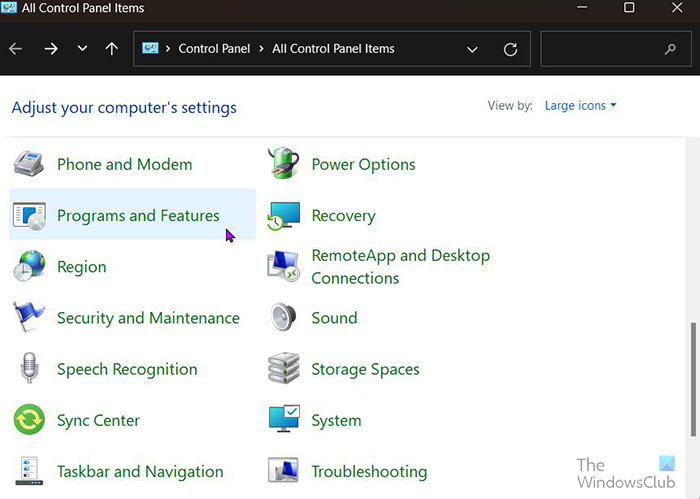
You will be taken to the Control panel items page, and click Programs and features.
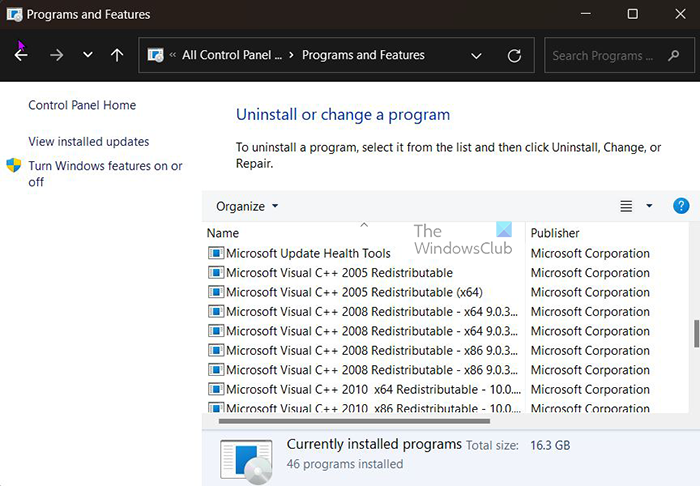
In the Program and features window click the plug-in that you want to uninstall and then click Uninstall at the top of the list. Confirm the uninstall and the plug-in will be uninstalled
You may also remove the plug-in or plug-ins by directly deleting them from the plug-in folder. Locate the plug-in folder then select the plug-in and press delete. You will be asked to confirm the deletion. Press ok and the file will be deleted.
Read: How to place Transparent Text on Image in Photoshop
How do I find plug-ins for Photoshop?
You can find plug-ins for Photoshop on the internet, however, ensure that it is a trusted source. If you are using a newer version of Photoshop you can get plugins by going to the top menu and clicking Window then Find extensions on Exchange. You can also visit the Adobe exchange website directly and download plug-ins. On the Adobe exchange website, you will find free and paid plug-ins.
What are some tasks that plug-ins can perform?
Many plug-ins are made for many different uses in Photoshop. Plug-ins add features that might otherwise not be available in Photoshop. Plugins can be used to automatically perform functions such as automating a process, editing images, adding filters, and much more.
Leave a Reply